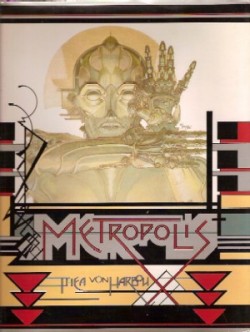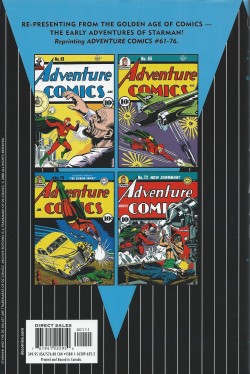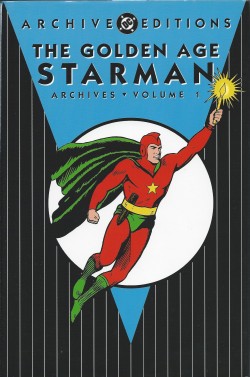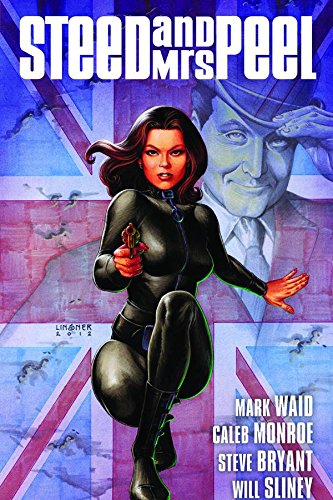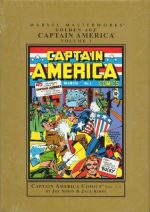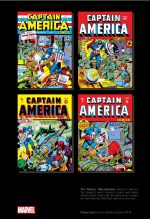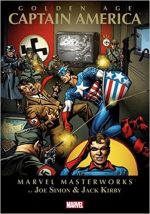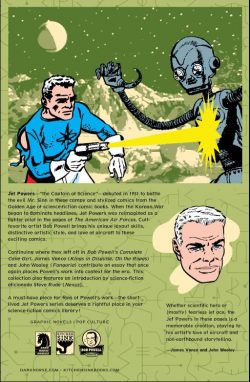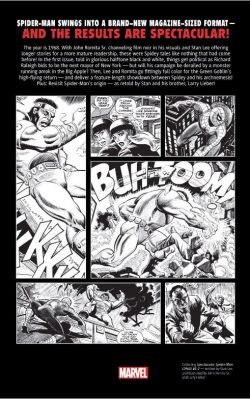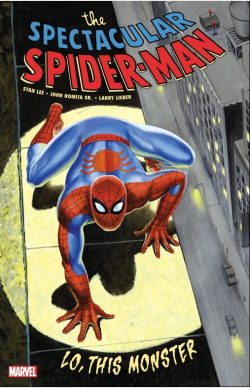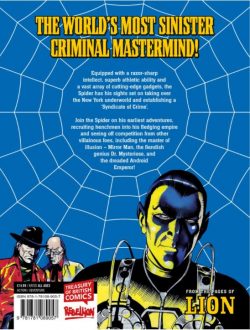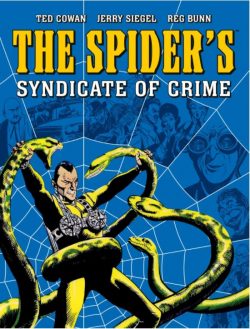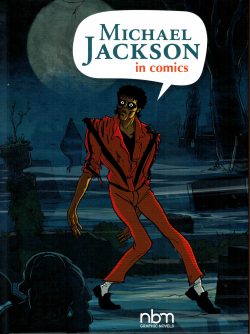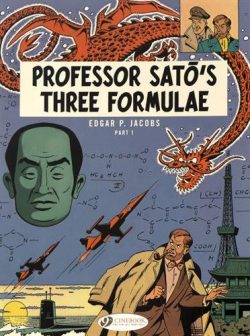
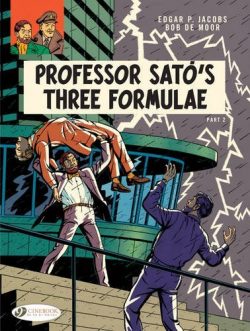
By Edgar P. Jacobs and Bob De Moor: with colours by Paul-Serge Marssignac, translated by Jerome Saincantin(Cinebook)
ISBN: 978-1-84918-292-8 (Album PB Pt 1) 978-1-84918-303-1(Album PB Pt 2)
Pre-eminent fantasy raconteur Edgar P. Jacobs devised one of the greatest heroic double acts in pulp fiction: pitting his distinguished scientific adventurers Professor Philip Mortimer and Captain Francis Blake against a daunting variety of perils and menaces in a sequence of stellar action-thrillers which blended science fiction scope, detective mystery suspense and supernatural thrills. The magic was made perfect through his stunning illustrations, rendered in the timeless Ligne Claire style which had made intrepid boy-reporter Tintin a global sensation.
The Doughty Duo debuted in September 1946; gracing the pages of the very first issue of Le Journal de Tintin: an ambitious international anthology comic with editions in Belgium, France and Holland. It was edited by Hergé, with his eponymous, world-famous star ably supplemented by a host of new heroes and features for the rapidly-changing post-war world. Bon anniversaire, Chaps!…
Les 3 formules du professeur SatÅ was a tragically extended affair and Jacob’s last hurrah. What became the 11th album was originally serialised between September 1971 and May 1972 in LJdT, after which the author abandoned his story due to failing health and personal issues.
Edgard Félix Pierre Jacobs died on February 20th 1987 and soon after, Bob de Moor was commissioned by the family and estate to complete the final tale from Jacob’s pencil roughs and script notes. The concluding album was finally released in March 1990. This led to a republishing of all the earlier exploits and eventually fresh adventures from a variety of creative teams…
Mortimer in Tokyo opens at Haneda Airport, where Air Traffic Controllers experience a unique problem when a UFO disrupts their carefully plotted flight courses. With disaster imminent, jets are scrambled to pursue the meteoric anomaly. Just before they perish, the pilots radio back that they are being attacked by a dragon…
As the news filters around the world, renowned cyberneticist Professor Akira SatŠargues with assistant Dr. Kim, deeply remorseful that his latest breakthrough has been the cause of such tragedy. Kim only barely dissuades his Sensei from turning himself in to the authorities but is utterly unable to convince or prevent SatŠfrom involving visiting colleague Philip Mortimer in his crisis of conscience…
The British scholar is in Kyoto attending a succession of scientific conferences, and when an ominous outsider overhears SatŒs intentions through hidden surveillance methods, the reaction is both explosive and potentially murderous…
The first Mortimer knows of the problem is when a gang of gunmen attempt to kidnap him off the streets, but after fighting them off and escaping, the old warrior returns to his hotel and finds a telegram waiting for him…
An urgent request to join old friend SatŠimmediately seems impossible due to stringencies of train timetabling, but an accommodating journalist overhears and offers a speedy compromise. Mortimer is suspicious of the happy accident… but not suspicious enough…
Surviving another assassination attempt by sheer force of will, the professor is then lost in the wilds of Japan before eventually battling his way to SatÅ’s lab outside Tokyo where he witnesses a series of astonishing sights.
His host has worked miracles in the fields of robotics – including the dragon which so recently and horrifically malfunctioned – but is at a loss to explain how his incredible creations have gone wrong at such a late stage. Worldly-wise Mortimer soon deduces the causes: espionage and sabotage…
As the British boffin sends for doughty comrade-in-arms Captain Blake, SatÅ is comforted by the fact that the key formulae for producing his mechanical marvels have been divided and deposited at three different banks in Tokyo. The Sensei breathes even easier after arranging that only Mortimer can retrieve them, but this only prompts their hidden enemy to accelerate his plans and reveal himself as one of Mortimer’s greatest foes…
Unable to induce or force Mortimer to retrieve the scientific goldmine, the mastermind has an android double constructed to fool the banks, but the rush-job breaks down before the task is completed. Now the vile villain has only more card to play before the formidable Blake arrives…
This edition – available as always in paperback album and digital formats – concludes with excerpts from other B & M albums, plus a short biographical feature and publication chart of Jacobs’ and his successors’ efforts to whet the appetite for further treats in store…
Cunning and convoluted, this devilishly devious tale unfolds with potent authenticity and ever-escalating tension, building to an explosive conclusion which eventually took eighteen years to conclude. At least we don’t have to wait that near-lifetime for the epic denouement…
Part 2: Mortimer versus Mortimer
Edgard Félix Pierre Jacobs (March 30th 1904-February 20th 1987) is deservedly considered a founding father of the Continental comics industry. Although his output was relatively modest compared to many of his contemporaries, Jacobs’ landmark serialised epic formed the backbone of the modern action-adventure comic in Europe.
His splendidly adroit, roguish, thoroughly British stars were conceived for the premier issue of Le Journal de Tintin, and quickly became a crucial staple of life for post-war European kids – in exactly the same way Dan Dare was for 1950s Britain.
Jacobs was Brussels-born: a precocious child perpetually drawing, but even more obsessed with music and performing arts – especially opera. He attended a commercial school but loathed the idea of office work, avidly pursuing arts and drama jobs after graduation in 1919.
A succession of such at opera-houses (scene-painting, set decoration and even performing as both an acting and singing extra) supplemented his private performance studies, and in 1929 Jacobs won an award from the Government for classical singing. His dreamed-of operatic career was thwarted by the Great Depression. When arts funding suffered massive cutbacks following the global stock market crash, he was compelled to pick up whatever dramatic work was going, although this did include more singing and performing.
In 1940, Jacobs switched to commercial illustration, winning regular work in the magazine Bravo, as well as illustrating short stories and novels. He famously took over the syndicated Flash Gordon strip after the occupying German authorities banned Alex Raymond’s quintessentially All-American Hero and the publishers desperately sought someone to satisfactorily complete the saga.
Jacobs’ ‘Stormer Gordon’ lasted less than a month before being similarly embargoed by the Occupation fun-police, after which the man of many talents simply created his own epic science-fantasy feature in the legendary Le Rayon U: a milestone in both Belgian comics and science fiction adventure.
During this period Jacobs and Tintin creator Hergé got together, and whilst creating the weekly U Ray strip, the younger man began assisting on Tintin, colouring the original black and white strips of The Shooting Star (originally published in newspaper Le Soir) for an upcoming album collection.
By 1944 Jacobs was performing similar duties on Tintin in the Congo, Tintin in America, King Ottokar’s Sceptre and The Blue Lotus. He was also contributing to the drawing too, working on extended epic we know as The Seven Crystal Balls and Prisoners of the Sun.
After the war and Europe was liberated, publisher Raymond Leblanc convinced Hergé, Jacobs and a few other comic strip stars to work for his proposed new venture. Founding publishing house Le Lombard, Leblanc also commissioned Le Journal de Tintin, an anthology comic with simultaneous editions in Belgium, France and Holland to be edited by Hergé and starring the intrepid boy reporter and a host of new heroes.
Beside Hergé, Jacobs and writer Jacques van Melkebeke, Le Journal de Tintin featured Paul Cuvelier’s Corentin and Jacques Laudy’s Legend of the Four Aymon Brothers.
As revealed in an enticing, photo-packed essay closing this Cinebook volume, Blake and Mortimer were a lucky compromise. Jacobs had wanted to create a period historical drama entitled Roland the Bold but changed genres due to an overabundance of such strips…
Laudy had been a friend of Jacobs since their time together on Bravo, and the first instalment of the epic thriller serial Le secret de l’Espadon starred a bluff, gruff British scientist and an English Military Intelligence officer closely modelled on Laudy himself…
The initial storyline ran from issue #1 (26th September 1946 to September 8th 1949): cementing Jacobs’ status as a star in his own right.
In 1950, with the first 18 pages slightly redrawn, The Secret of the Swordfish became Le Lombard’s first album release, with the concluding volume published three years later. The albums were reprinted nine more times between 1955 and 1982, in addition to a single omnibus edition released in 1964.
Hergé and Jacobs purportedly suffered a split in 1947 when the former refused to grant the latter a by-line on new Tintin material they had collaborated on, but since the two remained friends for life and Jacobs continued to produce Blake et Mortimer for the weekly, I think it’s fair to assume that if such was the case it was a pretty minor spat. I rather suspect that the Eccentric Englishmen were simply taking up more and more of the diligent artist’s time and attention…
Cinebook have made the Gentleman Heroes a bankable proposition, releasing the 29-and-counting albums, but suffice to say that the concluding instalment of Professor SatŒs Three Formulae was a long time coming …
Les 3 formules du professeur SatÅ – Mortimer contre Mortimer was a tragically extended affair and only credited Jacobs as writer and layout artist. The 11th album had been serialised between September 1971 and May 1972, after which the author simply dropped the story.
He died on February 20th 1987 and as cited veteran cartoonist Bob de Moor (Bart de Scheepsjongen, Monsieur Tric, Cori le Moussaillon, Balthazar, Barelli and so many others) was commissioned to complete his final tale from pencils and notes.
The concluding album was released in March 1990, sparking a republishing renaissance and new adventures from a variety of creative teams…
As previously described, boisterous boffin Mortimer is in Japan when contacted by robotics pioneer and cyberneticist supreme Professor Akira SatÅ. The savant has performed miracles in mass-production of highly specialised mechanoids and androids, but his discoveries – parsed down into three crucial processes and deposited in three separate banks – are targeted by a ruthless gang led by Blake and Mortimer’s greatest enemy.
The villains infiltrated Satős home and laboratory, tried to murder Mortimer numerous times and unleashed a robot duplicate of the scientist, but have been unable to stop a summons for help going out to his Secret Service ally. Now, with Blake imminently expected, the gang radically accelerate their timetable…
Blake is watched from the moment he disembarks at Haneda Airport and hidden enemies are already in place at his hotel. The MI5 chief has a suite next to Mortimer’s, and although his comrade is missing, finds plenty of clues as to what has happened to him. The diligent search also uncovers the video surveillance gear infesting both rooms and sets his watchers running for the exits in panic…
A hasty pursuit only leads to his own capture but, with fortune ever favouring the brave, Blake turns the tables on his foes in a deadly clash at the hotel garages, before sending them all fleeing for their lives.
By the time he has connected with Police Superintendent Hasumi and briefed Colonel Mitsu of the Japanese Public Security Intelligence Agency, the assailants have vanished, but Blake is building a picture of what is going on. To end the Englishman’s threat forever, a diabolical and desperate scheme is devised and a second Mortimer robot is built to assassinate Blake…
Turncoat assistant Kim is nervous. Although happy to use Satős incredible inventions to detain Mortimer and his former employer, the traitor is not conversant enough with production procedures to guarantee success. Nevertheless, a deadly doppelganger of the Professor is soon despatched to kill Blake…
The real Mortimer has not been idle. With Satős aid he has escaped the lab prison, rushing to intercept the android assassin, but unaware that behind him, unqualified hands have meddled with the duplication processes and a legion of horrific misfit mechanoids are tumbling off the conveyor belts…
What follows is a succession of spectacular chases, frantic battles and a final shattering showdown between Blake, Mortimer and the man who has bedevilled them since the Swordfish case – a fitting end to their exploits and, thanks to the graphic efforts of De Moor, a perfect, revitalising stepping stone for other creators to continue the feature…
Rocket-paced, suspenseful and cathartically action-packed, this is an enthralling changing-of-the-guard, building to an explosive conclusion and satisfying final flourish: another superbly stylish blockbuster to delight every adventure addict and Jacobs purist.
As well as the aforementioned historical overview – ‘Jacobs: 1946, the Swordfish, starting point of a masterful work’ – this Cinebook edition also includes excerpts from two other albums, a short biographical feature and publication chart of Jacobs’ and his successors’ efforts.
Vol 1: Original edition © Editions Blake & Mortimer/Studio Jacobs (Dargaud-Lombard S. A.) 1977 by E.P. Jacobs. All rights reserved. English translation © 2016 Cinebook Ltd.
Vol. 2: Original edition © Editions Blake & Mortimer/Studio Jacobs (Dargaud-Lombard s. a.) 1990 by E.P. Jacobs & Bob De Moor. All rights reserved. English translation © 2016 Cinebook Ltd.

